Light Energy Efficiency in Lettuce Crop: Structural Indoor Designs Simulation
Abstract
:1. Introduction
2. Results
3. Discussion
4. Materials and Methods
4.1. Variables Simulation
4.1.1. Yield in Dry Biomass by Photosynthetic Photons
4.1.2. Electricity Cost
4.1.3. Costs, Consumptions, and Mol of Photons per Kilogram
- Cost per kg harvested (Equation (6)):
- Electricity consumption per kg harvested (Equation (7)):
- Electricity consumption per kg of dry biomass (Equation (8)):
- Cost per kg of dry biomass (Equation (9)):
- Moles of photons per kg harvested (Equation (10)):
4.1.4. Cost of Electrical Energy Consumed for Lighting
4.2. Structural Designs
- Linear Static Light and Static Culture Bed with Linear Planting (LSL-LPS);
- Linear Static Light and Static Culture Bed with Quincunx Planting (LSL-QS);
- Circular Moving Light and Static Culture Bed with Linear Planting (CML-LPS);
- Circular Moving Light and Static Culture Bed with Quincunx Planting (CML-QS);
- Circular Moving Light and Mobile culture bed with linear planting (CML-LPM);
- Circular Moving Light and Mobile culture bed with quincunx planting (CML-QM);
- Linear Moving Light and Mobile Culture Bed with Linear Planting (LML-LPM);
- Linear Moving Light and Mobile culture bed with quincunx planting (LML-QM).
4.2.1. Illumination
- One focused on linear static luminaires where during the productive cycles, will not have movement or the option of gradual ignition.
- Two luminaires with mobile structures or with progressive lighting from the inside to the outside (circular light) or from one end to the other (linear light) to increase the beam of light as the plant grows in width.
4.2.2. Culture Bed and Planting Systems
5. Conclusions
Author Contributions
Funding
Data Availability Statement
Acknowledgments
Conflicts of Interest
References
- Hayashi, E.; Higgins, C. Global LED lighting players, economic analysis, and market creation for PFALs. In LED Lighting for Urban Agriculture; Kozai, T., Fujiwara, K., Runkle, E.S., Eds.; Springer: Singapore, 2016; Chapter 24; pp. 317–345. ISBN 978-981-10-1846-6. [Google Scholar] [CrossRef]
- Ting, K.C.; Lin, T.; Davidson, P.C. Integrated urban controlled environment agriculture systems. In LED Lighting for Urban Agriculture; Kozai, T., Fujiwara, K., Runkle, E.S., Eds.; Springer: Singapore, 2016; Chapter 2; pp. 21–37. ISBN 978-981-10-1846-6. [Google Scholar] [CrossRef]
- Ibaraki, Y. Lighting efficiency in plant production under artificial lighting and plant growth modeling for evaluating the lighting efficiency. In LED Lighting for Urban Agriculture; Kozai, T., Fujiwara, K., Runkle, E.S., Eds.; Springer: Singapore, 2016; Chapter 11; pp. 151–161. ISBN 978-981-10-1846-6. [Google Scholar] [CrossRef]
- Bugbee, B. Economics of LED lighting. In Light Emitting Diodes for Agriculture; Gupta, S.D., Ed.; Springer: Singapore, 2017; Chapter 5; pp. 81–99. ISBN 978-981-10-5806-6. [Google Scholar] [CrossRef]
- Kozai, T.; Zhang, G. Some aspects of the light environment. In LED Lighting for Urban Agriculture; Kozai, T., Fujiwara, K., Runkle, E.S., Eds.; Springer: Singapore, 2016; Chapter 4; pp. 49–55. ISBN 978-981-10-1846-6. [Google Scholar] [CrossRef]
- Akiyama, T.; Kozai, T. Light environment in the cultivation space of plant factory with LEDs. In LED Lighting for Urban Agriculture; Kozai, T., Fujiwara, K., Runkle, E.S., Eds.; Springer: Singapore, 2016; Chapter 7; pp. 91–109. ISBN 978-981-10-1846-6. [Google Scholar] [CrossRef]
- Jayalath, T.C.; van Iersel, M.W. Canopy Size and Light Use Efficiency Explain Growth Differences between Lettuce and Mizuna in Vertical Farms. Plants 2021, 10, 704. [Google Scholar] [CrossRef] [PubMed]
- Gupta, S.D.; Agarwal, A. Artificial lighting system for plant growth and development: Chronological advancement, working principles, and comparative assessment. In Light Emitting Diodes for Agriculture; Gupta, S.D., Ed.; Springer: Singapore, 2017; Chapter 1; pp. 1–24. ISBN 978-981-10-5806-6. [Google Scholar] [CrossRef]
- Ibaraki, Y. LED supplementary lighting. In Light Emitting Diodes for Agriculture; Gupta, S.D., Ed.; Springer: Singapore, 2017; Chapter 2; pp. 27–35. ISBN 978-981-10-5806-6. [Google Scholar] [CrossRef]
- Kozai, T.; Niu, G.; Takagaki, M. (Eds.) Plant Factory: An Indoor Vertical Farming System for Efficient Quality Food Production, 2nd ed.; Charlotte Cockle; Academic Press: Cambridge, MA, USA, 2020; pp. 419–475. ISBN 978-0-12-816691-8. [Google Scholar]
- Siregar, R.R.A.; Seminar, K.B.; Wahjuni, S.; Santosa, E. Vertical Farming Perspectives in Support of Precision Agriculture Using Artificial Intelligence: A Review. Computers 2022, 11, 135. [Google Scholar] [CrossRef]
- Saad, M.H.M.; Hamdan, N.M.; Sarker, M.R. State of the Art of Urban Smart Vertical Farming Automation System: Advanced Topologies, Issues and Recommendations. Electronics 2021, 10, 1422. [Google Scholar] [CrossRef]
- Watawana, B.; Isaksson, M. Design and Simulations of a Self-Assembling Autonomous Vertical Farm for Urban Farming. Agriculture 2023, 13, 112. [Google Scholar] [CrossRef]
- Gu, S.; Ji, H.; Yang, Y.; Chu, Q.; Yang, Y.; Liu, H.; Jiang, X. Analysis on Transporting Methods of Cultivation Unit for Vertical Cultivation in Plant Factory. Agriculture 2021, 11, 989. [Google Scholar] [CrossRef]
- Delorme, M.; Santini, A. Energy-efficient automated vertical farms. Omega 2022, 109, 102611. [Google Scholar] [CrossRef]
- Craver, J.K.; Lopez, R.G. Control of Morphology by Manipulating Light Quality and Daily Light Integral Using LEDs. In LED Lighting for Urban Agriculture; Kozai, T., Fujiwara, K., Runkle, E., Eds.; Springer: Singapore, 2016. [Google Scholar] [CrossRef]
- Runkle, E.S. Recent Developments in Plant Lighting. In LED Lighting for Urban Agriculture; Kozai, T., Fujiwara, K., Runkle, E., Eds.; Springer: Singapore, 2016. [Google Scholar] [CrossRef]
- Fujiwara, K. Basics of LEDs for Plant Cultivation. In LED Lighting for Urban Agriculture; Kozai, T., Fujiwara, K., Runkle, E., Eds.; Springer: Singapore, 2016. [Google Scholar] [CrossRef]
- Kozai, T.; Niu, G. Plant factory as a resource-efficient closed plant production system. In Plant Factory: An Indoor Vertical Farming System for Efficient Quality Food Production; Kozai, T., Niu, G., Takagaki, M., Eds.; Charlotte Cockle; Academic Press: Cambridge, MA, USA, 2020; Chapter 5; pp. 93–112. ISBN 978-0-12-816691-8. [Google Scholar]
- Shatilov, M.; Razin, A.; Ivanova, M. Analysis of the world lettuce market. IOP Conf. Ser. Earth Environ. Sci. 2019, 395, 012053. [Google Scholar] [CrossRef]
- FAOSTAT. Crops and Livestock Products, Lettuce and Chicory. Available online: https://www.fao.org/faostat/en/#data/QCL/visualize (accessed on 8 May 2023).
- Ministerio de Agricultura, Pesca y Alimentación; Subdirección General de Análisis, Coordinación y Estadística. Precios Coyunturales, Informe Semanal de Coyuntura, Semana 13. 2023. Available online: https://www.mapa.gob.es/es/estadistica/temas/publicaciones/informesemanaldecoyuntura2023s-13_tcm30-649653.pdf (accessed on 8 May 2023).
- Barbosa, G.L.; Gadelha, F.D.A.; Kublik, N.; Proctor, A.; Reichelm, L.; Weissinger, E.; Wohlleb, G.M.; Halden, R.U. Comparison of Land, Water, and Energy Requirements of Lettuce Grown Using Hydroponic vs.Conventional Agricultural Methods. Int. J. Environ. Res. Public Health 2015, 12, 6879–6891. [Google Scholar] [CrossRef]
- Cichocki, J.; von Cossel, M.; Winkler, B. Techno-Economic Assessment of an Office-Based Indoor Farming Unit. Agronomy 2022, 12, 3182. [Google Scholar] [CrossRef]
- Seong, J.; Valle de Souza, S.; Peterson, H.C. Seeds of Industry Sustainability: Consumer Attitudes towards Indoor Agriculture Benefits versus Its Advanced Technology. Sustainability 2023, 15, 2369. [Google Scholar] [CrossRef]
- Chavan, S.G.; Chen, Z.-H.; Ghannoum, O.; Cazzonelli, C.I.; Tissue, D.T. Current Technologies and Target Crops: A Review on Australian Protected Cropping. Crops 2022, 2, 172–185. [Google Scholar] [CrossRef]
- Morella, P.; Lambán, M.P.; Royo, J.; Sánchez, J.C. Vertical Farming Monitoring: How Does It Work and How Much Does It Cost? Sensors 2023, 23, 3502. [Google Scholar] [CrossRef]
- Bugbee, B. Turning Photons into Food. Calculating Potential Yield in Optimal Environments. Utah State University, Utah, United States of America. 20 October 2019. Available online: https://www.youtube.com/watch?v=wsaufB5F8dk&t=146s (accessed on 15 June 2023).
- Ibaraki, Y. Evaluation of Spatial Light Environment and Plant Canopy Structure. In LED Lighting for Urban Agriculture; Kozai, T., Fujiwara, K., Runkle, E., Eds.; Springer: Singapore, 2016. [Google Scholar] [CrossRef]
- Nelson, J.A.; Bugbee, B. Economic analysis of greenhouse lighting: Light emitting diodes vs. high intensity discharge fixtures. PLoS ONE 2014, 9, e99010. [Google Scholar] [CrossRef] [PubMed]
- Seginer, I.; Ioslovich, I. Optimal spacing and cultivation intensity for an industrialized crop production system. Agric. Syst. 1999, 62, 143–157. [Google Scholar] [CrossRef]
- Balasus, J.; Blank, J.; Babilon, S.; Hegemann, T.; Khanh, T.Q. Energy Efficient Lighting in Plant Factories: Addressing Utilance. Agronomy 2021, 11, 2570. [Google Scholar] [CrossRef]
- Dufresne, S.A.; Van Geest, I. Multilevel Mobile Gutter System for Growing Indoor Vegetation. U.S. Patent 10390504B2, 27 October 2019. [Google Scholar]
- Dufresne, S.A. Automated Mobile Terrace Growing System. U.S. Patent 11343985B2, 31 May 2022. [Google Scholar]
- Cuello, J.L.; Mehdipour, Y.; Welchert, J. Mobile and Modular Cultivation Systems for Vertical Farming. U.S. Patent WO2020041762A1, 27 February 2020. [Google Scholar]
- Kim, J.; Kang, W.H.; Son, J.E. Interpretation and Evaluation of Electrical Lighting in Plant Factories with Ray-Tracing Simulation and 3D Plant Modeling. Agronomy 2020, 10, 1545. [Google Scholar] [CrossRef]
- Saito, K.; Ishigami, Y.; Goto, E. Evaluation of the Light Environment of a Plant Factory with Artificial Light by Using an Optical Simulation. Agronomy 2020, 10, 1663. [Google Scholar] [CrossRef]
- Balázs, L.; Dombi, Z.; Csambalik, L.; Sipos, L. Characterizing the Spatial Uniformity of Light Intensity and Spectrum for Indoor Crop Production. Horticulturae 2022, 8, 644. [Google Scholar] [CrossRef]
- Nájera, C.; Gallegos-Cedillo, V.M.; Ros, M.; Pascual, J.A. Role of Spectrum-Light on Productivity, and Plant Quality over Vertical Farming Systems: Bibliometric Analysis. Horticulturae 2023, 9, 63. [Google Scholar] [CrossRef]
- Nájera, C.; Gallegos-Cedillo, V.M.; Ros, M.; Pascual, J.A. LED Lighting in Vertical Farming Systems Enhances Bioactive Compounds and Productivity of Vegetables Crops. Biol. Life Sci. Forum 2022, 16, 24. [Google Scholar] [CrossRef]
- Li, Q.; Li, X.; Tang, B.; Gu, M. Growth Responses and Root Characteristics of Lettuce Grown in Aeroponics, Hydroponics, and Substrate Culture. Horticulturae 2018, 4, 35. [Google Scholar] [CrossRef]
- Khater, E. Comparison between hydroponic and aeroponic systems for lettuce production. In Proceedings of the 20th Annual Conference of Misr Society of Agricultural Engineering, Cairo, Egypt, 12 December 2015. [Google Scholar]
- Ali Hamuda, G.M. Growth and Development of Lettuce (Lactuca sativa L.) in A Hydroponic System with Different Lighting Sources. Master’s Thesis, Science in Horticultural, United Arab Emirates University, Abu Dhabi, United Arab Emirates, 2018. Available online: https://scholarworks.uaeu.ac.ae/aridland_theses/1 (accessed on 6 June 2023).
- Volk, T.; Bugbee, B.; Wheeler, R. An approach to crop modeling with the energy cascade. Life Support Biosph. Sci. Int. J. Earth Space 1995, 1, 119–127. [Google Scholar]
- Bugbee, B.G.; Salisbury, F.B. Exploring the limits of crop productivity. I. Photosynthetic efficiency of wheat in high irradiance environments. Plant Physiol. 1988, 88, 869–878. [Google Scholar] [CrossRef] [PubMed]
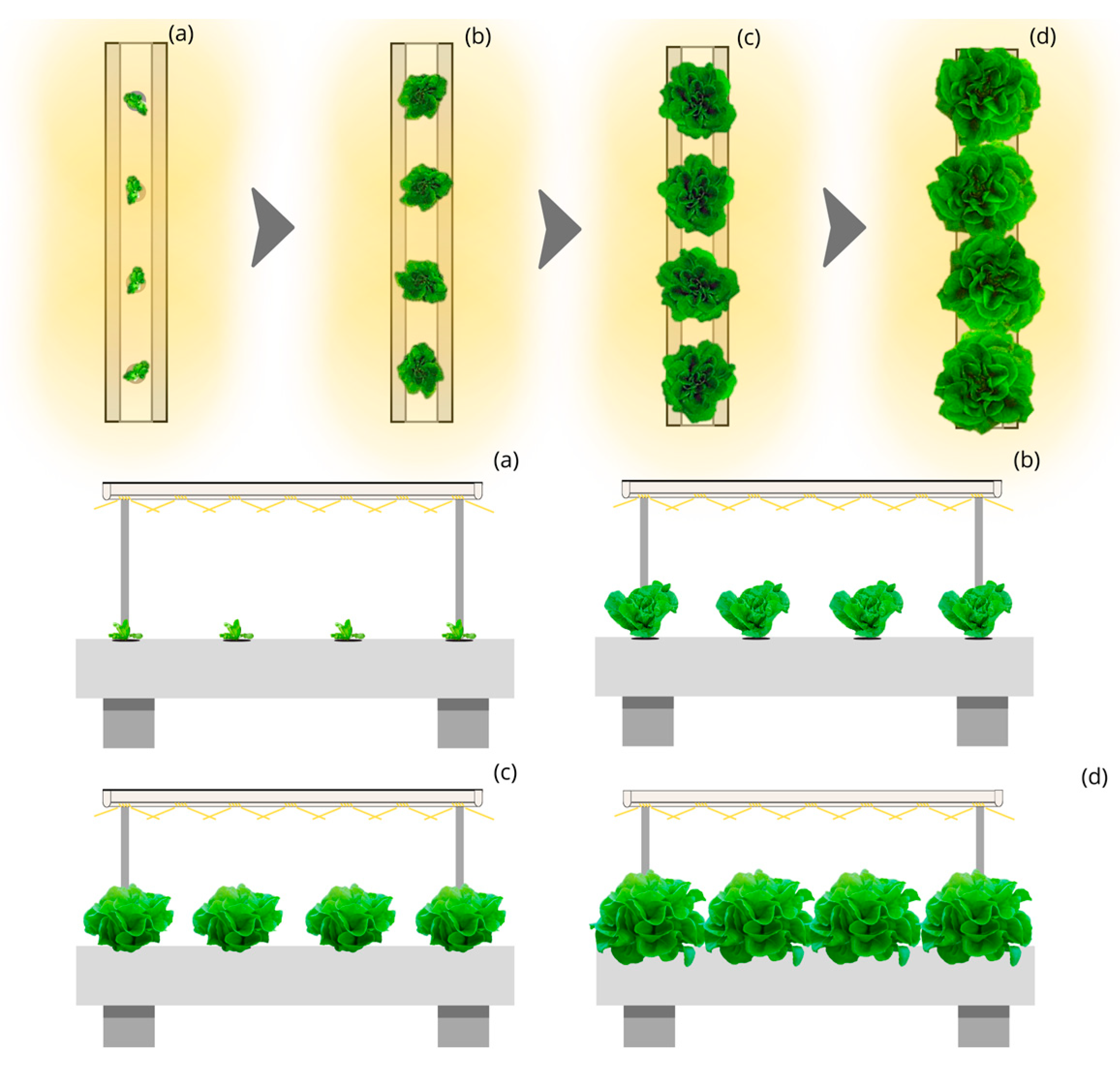
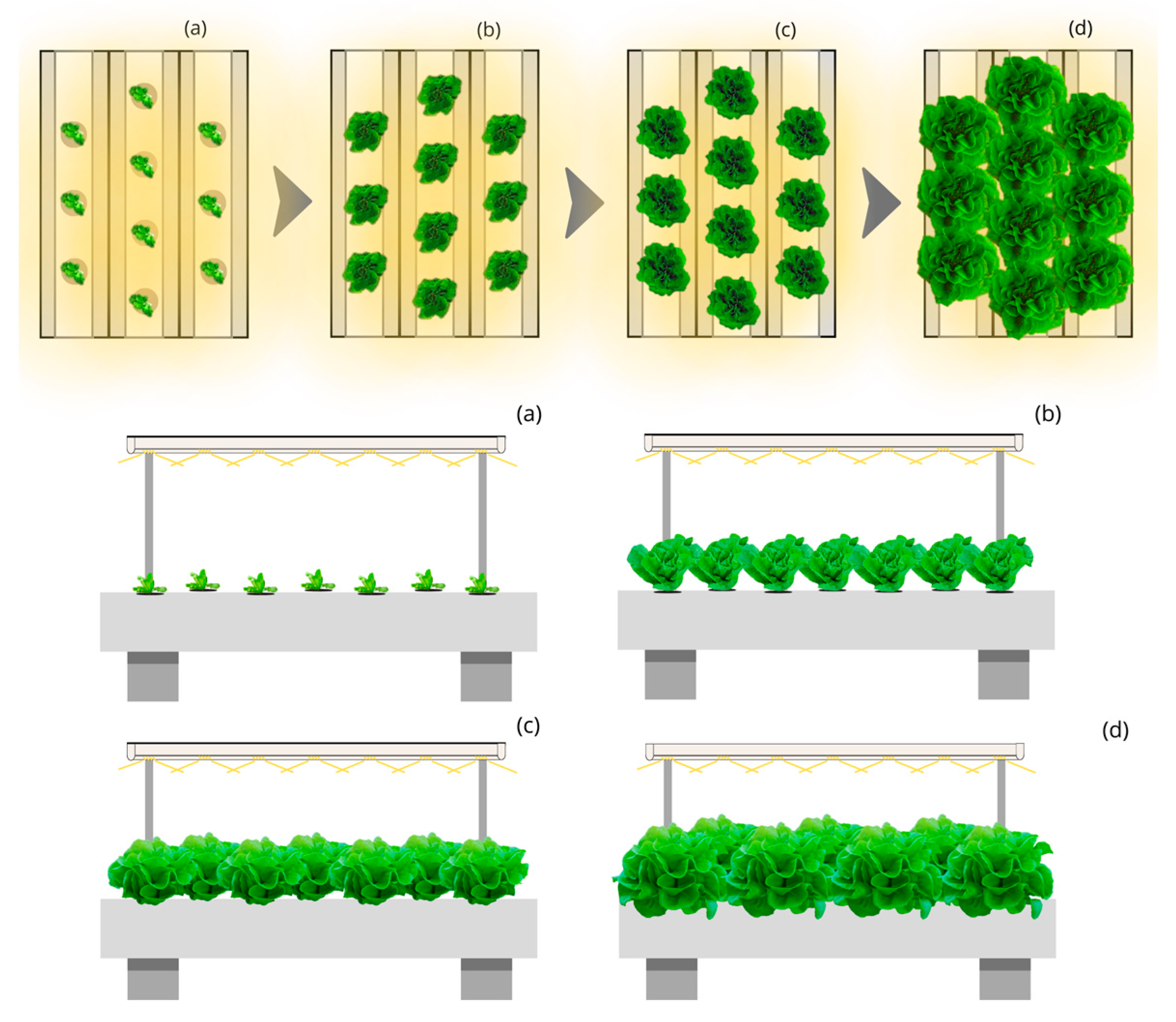

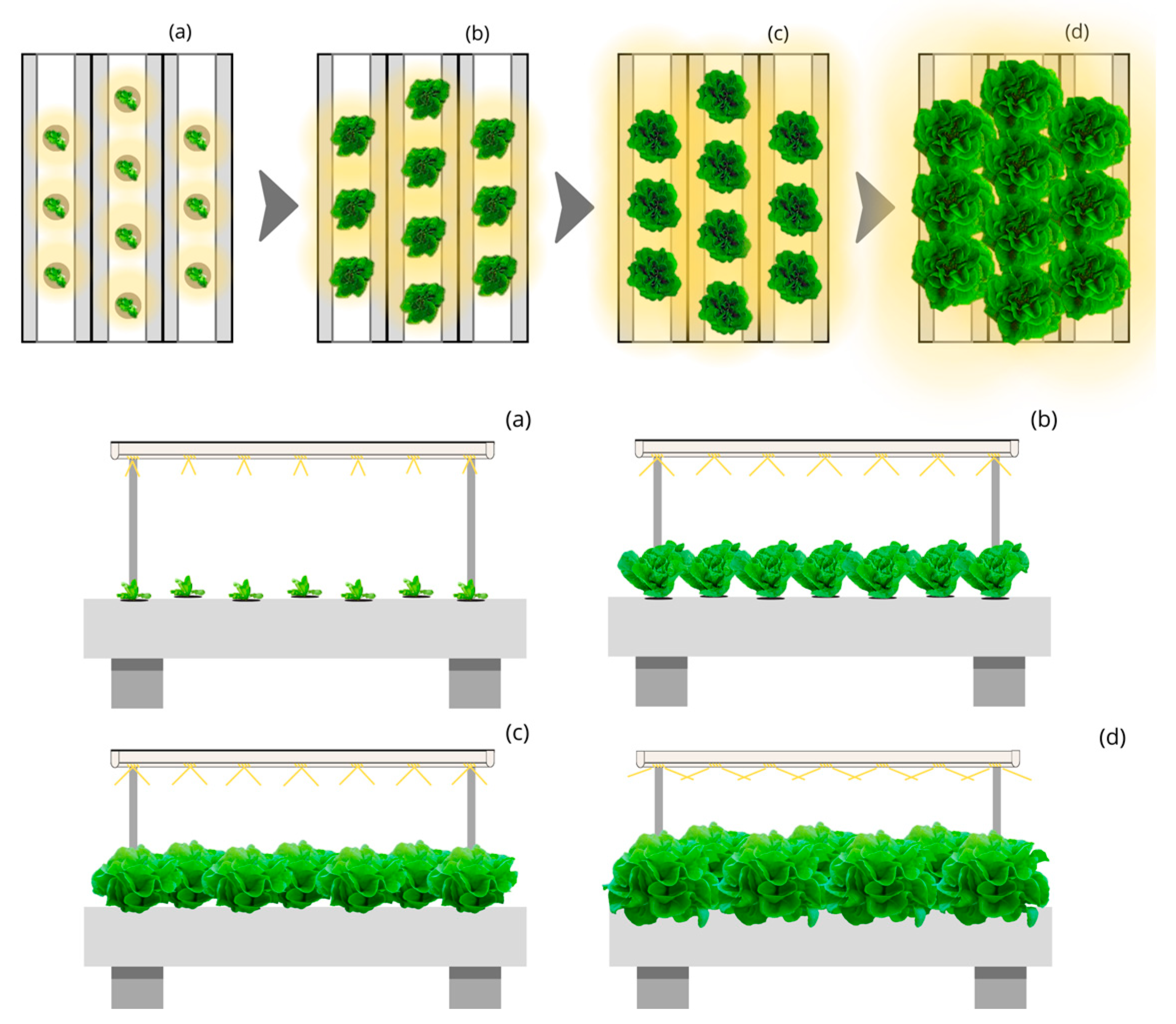
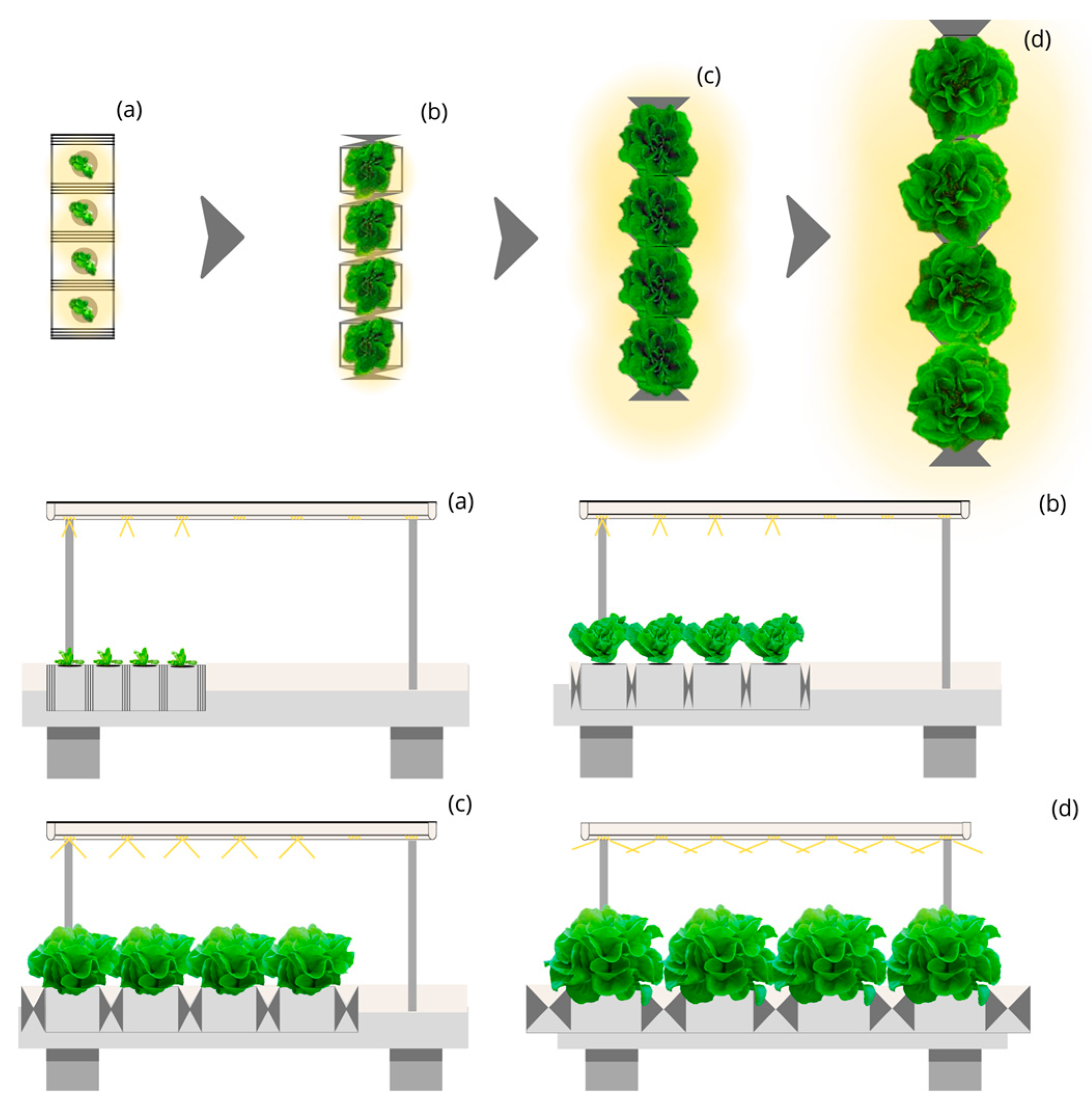
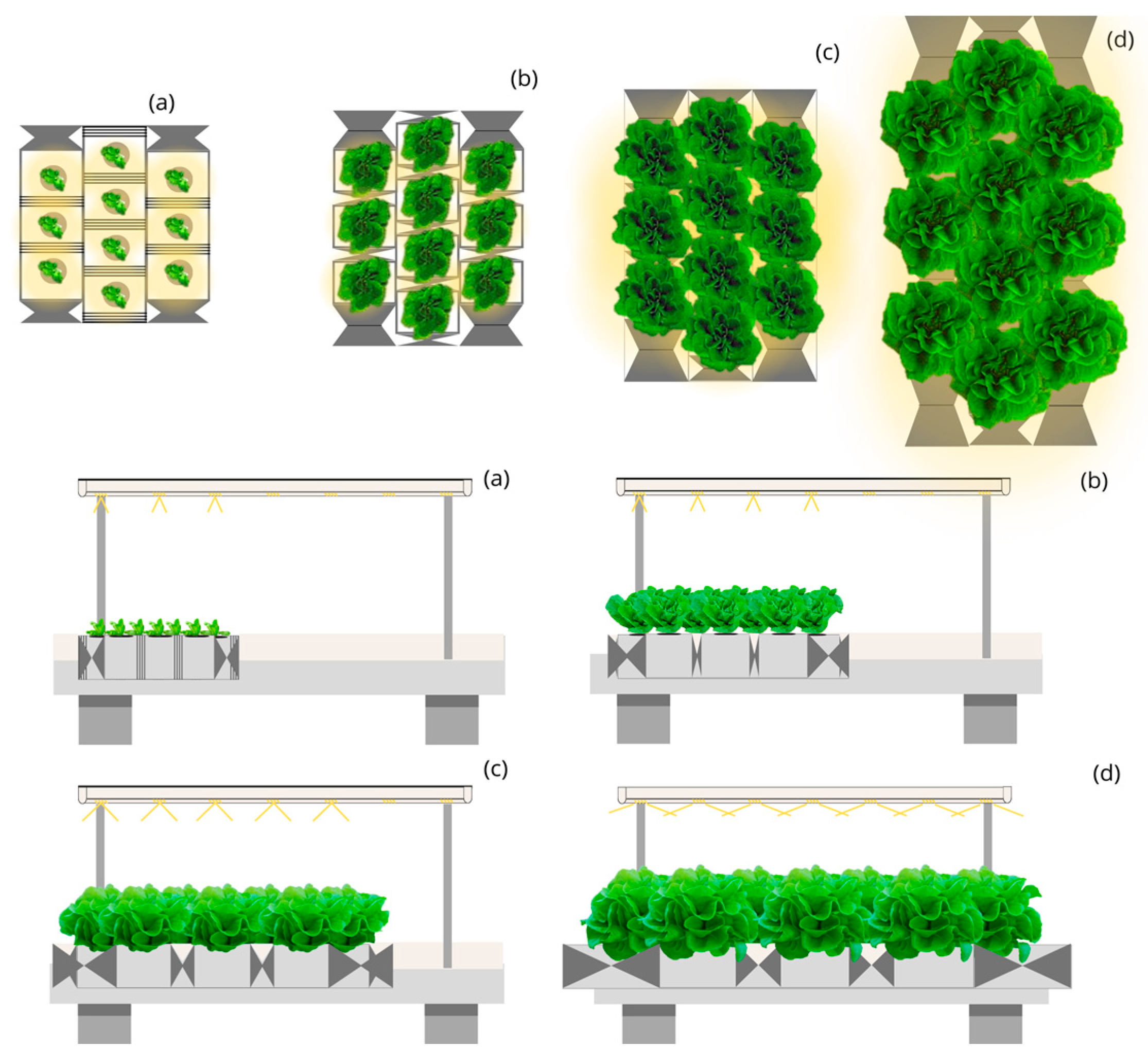
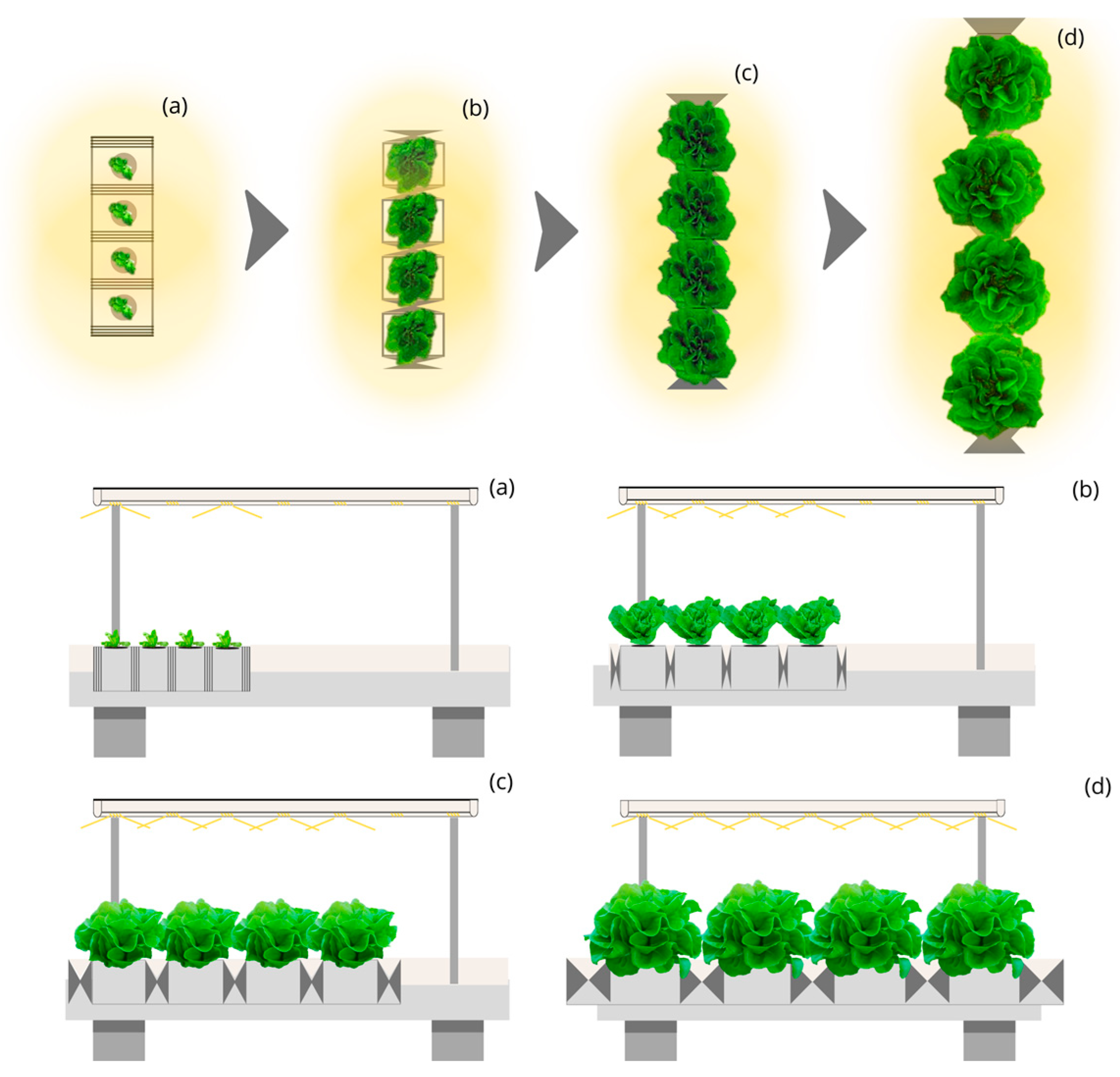
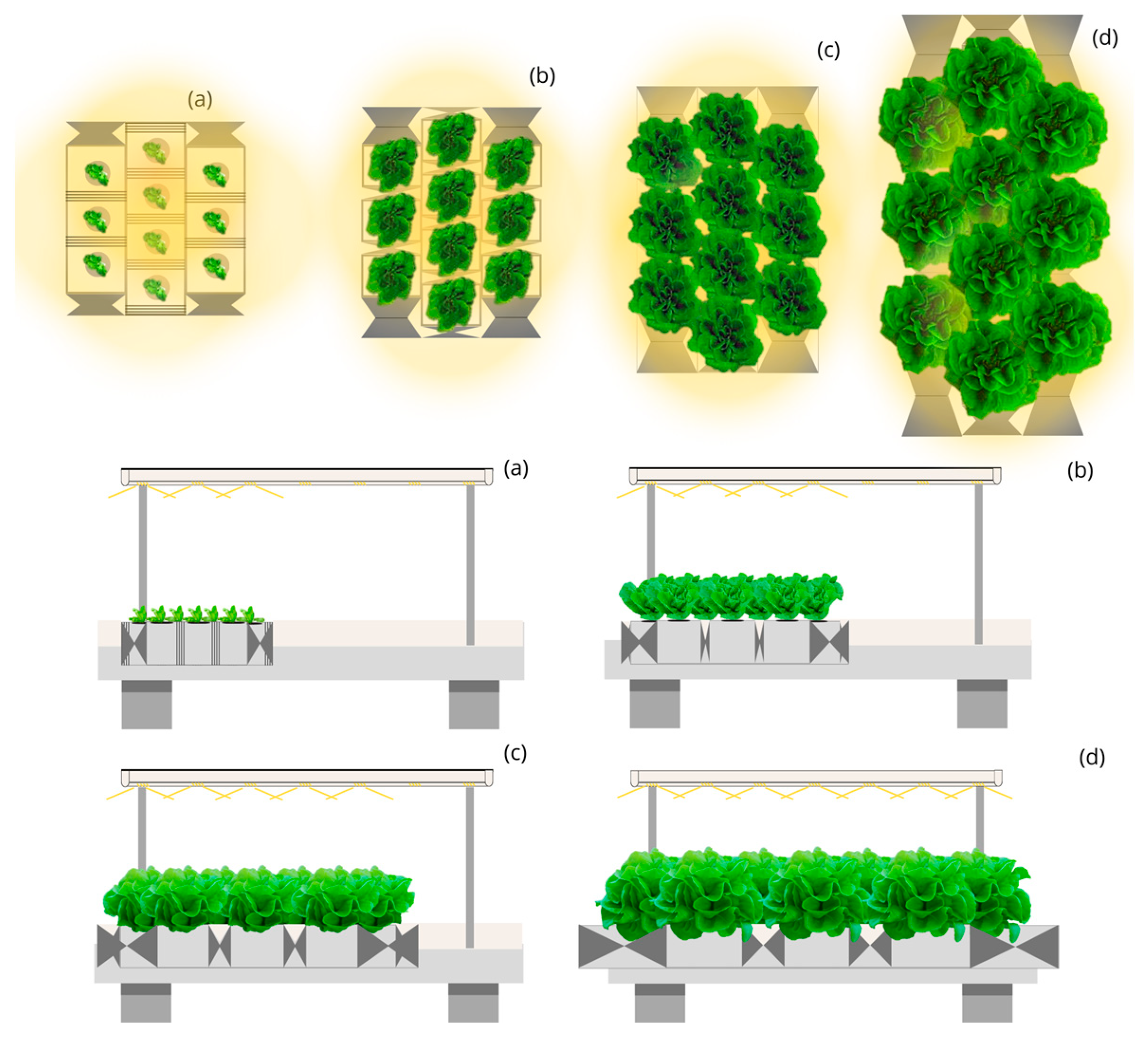

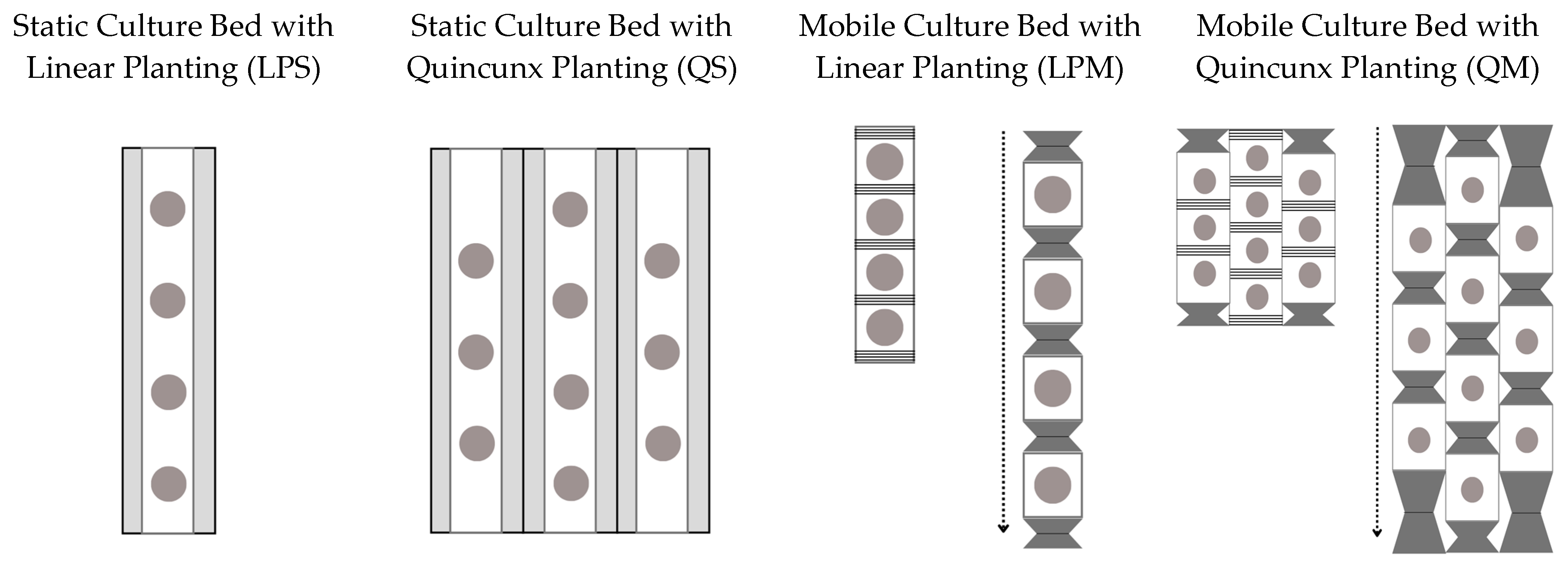
| LSL-LPS | LSL-QS | CML-LPS | CML-QS | LML-LPM | LML-QM | CML-LPM | CML-QM | Hypothetical Structures | ||
|---|---|---|---|---|---|---|---|---|---|---|
| 50% | 55% | 60% | 65% | 70% | 75% | 80% | 85% | 90% | 95% | |
| 500 | 4152 | 3775 | 3460 | 3194 | 2966 | 2768 | 2595 | 2442 | 2307 | 2185 |
| 1000 | 8304 | 7549 | 6920 | 6388 | 5932 | 5536 | 5190 | 4885 | 4613 | 4371 |
| 1500 | 12,456 | 11,324 | 10,380 | 9582 | 8897 | 8304 | 7785 | 7327 | 6920 | 6556 |
| 2000 | 16,608 | 15,098 | 13,840 | 12,776 | 11,863 | 11,072 | 10,380 | 9770 | 9227 | 8741 |
| 2500 | 20,760 | 18,873 | 17,300 | 15,969 | 14,829 | 13,840 | 12,975 | 12,212 | 11,533 | 10,926 |
| 3000 | 24,912 | 22,648 | 20,760 | 19,163 | 17,795 | 16,608 | 15,570 | 14,654 | 13,840 | 13,112 |
| 3500 | 29,064 | 26,422 | 24,220 | 22,357 | 20,760 | 19,376 | 18,165 | 17,097 | 16,147 | 15,297 |
| 4000 | 33,216 | 30,197 | 27,680 | 25,551 | 23,726 | 22,144 | 20,760 | 19,539 | 18,454 | 17,482 |
| 4500 | 37,368 | 33,971 | 31,140 | 28,745 | 26,692 | 24,912 | 23,355 | 21,981 | 20,760 | 19,668 |
| 5000 | 41,521 | 37,746 | 34,600 | 31,939 | 29,658 | 27,680 | 25,950 | 24,424 | 23,067 | 21,853 |
| 5500 | 45,673 | 41,521 | 38,060 | 35,133 | 32,623 | 30,448 | 28,545 | 26,866 | 25,374 | 24,038 |
| 6000 | 49,825 | 45,295 | 41,521 | 38,327 | 35,589 | 33,216 | 31,140 | 29,309 | 27,680 | 26,223 |
| 6500 | 53,977 | 49,070 | 44,981 | 41,521 | 38,555 | 35,984 | 33,735 | 31,751 | 29,987 | 28,409 |
| 7000 | 58,129 | 52,844 | 48,441 | 44,714 | 41,521 | 38,752 | 36,330 | 34,193 | 32,294 | 30,594 |
| 7500 | 62,281 | 56,619 | 51,901 | 47,908 | 44,486 | 41,521 | 38,925 | 36,636 | 34,600 | 32,779 |
| LSL-LPS | LSL-QS | CML-LPS | CML-QS | LML-LPM | LML-QM | CML-LPM | CML-QM | Hypothetical Structures | ||
|---|---|---|---|---|---|---|---|---|---|---|
| 50% | 55% | 60% | 65% | 70% | 75% | 80% | 85% | 90% | 95% | |
| 500 | 955 | 868 | 796 | 735 | 682 | 637 | 597 | 562 | 531 | 503 |
| 1000 | 1910 | 1736 | 1592 | 1469 | 1364 | 1273 | 1194 | 1123 | 1061 | 1005 |
| 1500 | 2865 | 2604 | 2387 | 2204 | 2046 | 1910 | 1791 | 1685 | 1592 | 1508 |
| 2000 | 3820 | 3473 | 3183 | 2938 | 2728 | 2547 | 2387 | 2247 | 2122 | 2010 |
| 2500 | 4775 | 4341 | 3979 | 3673 | 3411 | 3183 | 2984 | 2809 | 2653 | 2513 |
| 3000 | 5730 | 5209 | 4775 | 4408 | 4093 | 3820 | 3581 | 3370 | 3183 | 3016 |
| 3500 | 6685 | 6077 | 5571 | 5142 | 4775 | 4457 | 4178 | 3932 | 3714 | 3518 |
| 4000 | 7640 | 6945 | 6366 | 5877 | 5457 | 5093 | 4775 | 4494 | 4244 | 4021 |
| 4500 | 8595 | 7813 | 7162 | 6611 | 6139 | 5730 | 5372 | 5056 | 4775 | 4524 |
| 5000 | 9550 | 8682 | 7958 | 7346 | 6821 | 6366 | 5969 | 5617 | 5305 | 5026 |
| 5500 | 10,505 | 9550 | 8754 | 8081 | 7503 | 7003 | 6565 | 6179 | 5836 | 5529 |
| 6000 | 11,460 | 10,418 | 9550 | 8815 | 8185 | 7640 | 7162 | 6741 | 6366 | 6031 |
| 6500 | 12,415 | 11,286 | 10,346 | 9550 | 8868 | 8276 | 7759 | 7303 | 6897 | 6534 |
| 7000 | 13,370 | 12,154 | 11,141 | 10,284 | 9550 | 8913 | 8356 | 7864 | 7428 | 7037 |
| 7500 | 14,325 | 13,022 | 11,937 | 11,019 | 10,232 | 9550 | 8953 | 8426 | 7958 | 7539 |
Disclaimer/Publisher’s Note: The statements, opinions and data contained in all publications are solely those of the individual author(s) and contributor(s) and not of MDPI and/or the editor(s). MDPI and/or the editor(s) disclaim responsibility for any injury to people or property resulting from any ideas, methods, instructions or products referred to in the content. |
© 2023 by the authors. Licensee MDPI, Basel, Switzerland. This article is an open access article distributed under the terms and conditions of the Creative Commons Attribution (CC BY) license (https://creativecommons.org/licenses/by/4.0/).
Share and Cite
Lozano-Castellanos, L.F.; Navas-Gracia, L.M.; Correa-Guimaraes, A. Light Energy Efficiency in Lettuce Crop: Structural Indoor Designs Simulation. Plants 2023, 12, 3456. https://doi.org/10.3390/plants12193456
Lozano-Castellanos LF, Navas-Gracia LM, Correa-Guimaraes A. Light Energy Efficiency in Lettuce Crop: Structural Indoor Designs Simulation. Plants. 2023; 12(19):3456. https://doi.org/10.3390/plants12193456
Chicago/Turabian StyleLozano-Castellanos, Luisa F., Luis Manuel Navas-Gracia, and Adriana Correa-Guimaraes. 2023. "Light Energy Efficiency in Lettuce Crop: Structural Indoor Designs Simulation" Plants 12, no. 19: 3456. https://doi.org/10.3390/plants12193456
APA StyleLozano-Castellanos, L. F., Navas-Gracia, L. M., & Correa-Guimaraes, A. (2023). Light Energy Efficiency in Lettuce Crop: Structural Indoor Designs Simulation. Plants, 12(19), 3456. https://doi.org/10.3390/plants12193456









